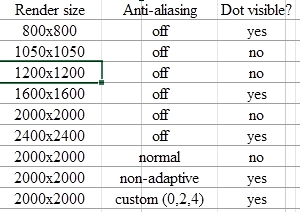Here's a test case, a base layer all white, a second layer with a small black dot in the center. (The fractal where the problem came up was more complicated!) The black dot is a circle with a radius of .01 in a window of width 4, so at 800x800 it's 4 pixels wide and shows up clearly in the UF window, with or without anti-aliasing.
Problem: sometimes the rendered image does not show the black dot at all! Here's a bit of a table pasted from a screenshot of an Excel display:

I hope this is not just my machine (or my incompetence).
UF 6.04, Windows 10 pro, version 21h2, 64-bit
The upr for anyone to verify this strange result:
tmp {
::s5TZshn29i1ySuqNQ09TVz/Al3bbJZemUs5msJpyiUV+ASpAy26eFIKQMec+6TLh4tkndZzM
mj6+0tO0tgmrt0CFV8Tv/WQgirEs8DqqmDBP4lq75pIUwdG/2dl5nC6TWbXORbcRLrkr6yP8
78qgvJ6Z/c8ZM5MBRIHCo1KOVwpd86b5PZdv/mxVTUKoNKusO/QJt9HBFsaFrNoRyrVHCkN0
Cu6ZOGCmqlW31QbBDGooi20A8NQixtc0ZUQF9WdOew8ry2quc87vNdlx6OpgXmjCuyFsaaFs
HLr++lT9fe9QAQU7zBgj/KT0/J7XEcTgOodt5vLgL/A226cGjwACvujXyk9K9/yt/Hw7ANhV
3yEUF/DWetcgA51rdMFtS2D7E0J0MU9NQvHQalKqRWGus7u8xdadpg1Nxj96aZTL7DO7hWVc
A3x/XWOJJajTgOWCK2GfGQNugjRoV+8gruX3X9P6b5rcTvggXz2ArJJdJDD1QEz2h2wyL4tF
CtQN8D1TA7gtAAcIgVejNK6GL6baYtC2VV+R8Z8EsQ+g12aqKxnPOjPWUc6MaJLaazPhwnRr
gwaSXDRA+256FoKTHDmAKE6sZ9V+nsyAzNQbGbXeVKjOFNvy6sGWavfjruyvc08vnL7X5sS2
oxW61AV2dYLrQ5Lv1rtTn1g7V5JTHRxzUYrltXto90GdTGOSycyNQQjU88msefKOvmsVX9ex
0cYhshcFFrC8ImstGwwLxM1Eri/Dedp+0qDUhIYoDfM8dKaL0Fu4qt3HGxHyy0FICeFXljWg
0Pdb0cq2o72No9Kz5h45aoJMyssPhBVonSiM1ULhDBYiBe8wgpliy1GrXisyl4F4bcJxjLp+
dJzjLYkffwYfORehTX85U4LcynIgfhKg9JD4XoDYfCBZvQU03+BbqWkXDP5RFIh/KoNdHGNw
WRuwl1VlLRnrJngsFlbcfVh54CzllmL195gNYavSOX/uap5iWD8Ylsefi3YLxPNE7xFzcQGq
y1/ZEvQI7gDtXJEW/vMS9Wc7hvroWfE/R8CSMEfZonfp3heYN0upXQhtFEPvLMkGun0I/qQk
LxMaHpROlgYPJbsLSjnPXZm349JbiHST8oAJ7S2k9km6XBSdlsp7IN1pCk5JZzcRamLFIbfy
iReYVfsmTNAWYb+CQ7J+VdVubrw7JG7UJwEfJNxJxEXiBm4Ip91opPT2tacZfS7oVDH+C1I0
ZSvvbDH6WNi8l0Ob4wROVjIHJtveOcsP1IefS7otDn8C1IxZSvvzDn4WNS9l0Ob+wpOVjUHJ
tv+PcmP1IbfS7oFkgexDOQuSaCaIp1jE2LompCrofy1PtTPs58kh/FwDMZa5p+rVTTH+nw7k
KgXYe49CHGW2MhJT/Y4a27vZnC0sUJDMTPF7pLosMMZ2W9UT0WnRrQYehcbA/GM6ch+x9m3J
+3g00Md47vdrlWyBjMBCo7HsSjA3VJlwwW6fONKJ+CCeT2S2n54k0gCpQCvcwESmZOaDIOOJ
JhgjsrdBeCrnFiHpB2xDzqPMg9XG9xJ7JRRzZwSUNNzhfv56YvycHfRh/QDFgX/dEqYq7yyc
42ui3Q7+qPkg7akowkAYwni7sifkDTvHQL/efn5DT4r2Zxdzvq8x+BKCJpRhxhRJxrrn2W+M
adWYWcCJL6/r6pjpT37iRbqQmv9hjxbq1OeJZHS8O//q6p1R3R9EEXn1T6wv3cdKsy8/DMUp
fFH=
}
Here's a test case, a base layer all white, a second layer with a small black dot in the center. (The fractal where the problem came up was more complicated!) The black dot is a circle with a radius of .01 in a window of width 4, so at 800x800 it's 4 pixels wide and shows up clearly in the UF window, with or without anti-aliasing.
Problem: sometimes the rendered image does not show the black dot at all! Here's a bit of a table pasted from a screenshot of an Excel display:

I hope this is not just my machine (or my incompetence).
UF 6.04, Windows 10 pro, version 21h2, 64-bit
The upr for anyone to verify this strange result:
tmp {
::s5TZshn29i1ySuqNQ09TVz/Al3bbJZemUs5msJpyiUV+ASpAy26eFIKQMec+6TLh4tkndZzM
mj6+0tO0tgmrt0CFV8Tv/WQgirEs8DqqmDBP4lq75pIUwdG/2dl5nC6TWbXORbcRLrkr6yP8
78qgvJ6Z/c8ZM5MBRIHCo1KOVwpd86b5PZdv/mxVTUKoNKusO/QJt9HBFsaFrNoRyrVHCkN0
Cu6ZOGCmqlW31QbBDGooi20A8NQixtc0ZUQF9WdOew8ry2quc87vNdlx6OpgXmjCuyFsaaFs
HLr++lT9fe9QAQU7zBgj/KT0/J7XEcTgOodt5vLgL/A226cGjwACvujXyk9K9/yt/Hw7ANhV
3yEUF/DWetcgA51rdMFtS2D7E0J0MU9NQvHQalKqRWGus7u8xdadpg1Nxj96aZTL7DO7hWVc
A3x/XWOJJajTgOWCK2GfGQNugjRoV+8gruX3X9P6b5rcTvggXz2ArJJdJDD1QEz2h2wyL4tF
CtQN8D1TA7gtAAcIgVejNK6GL6baYtC2VV+R8Z8EsQ+g12aqKxnPOjPWUc6MaJLaazPhwnRr
gwaSXDRA+256FoKTHDmAKE6sZ9V+nsyAzNQbGbXeVKjOFNvy6sGWavfjruyvc08vnL7X5sS2
oxW61AV2dYLrQ5Lv1rtTn1g7V5JTHRxzUYrltXto90GdTGOSycyNQQjU88msefKOvmsVX9ex
0cYhshcFFrC8ImstGwwLxM1Eri/Dedp+0qDUhIYoDfM8dKaL0Fu4qt3HGxHyy0FICeFXljWg
0Pdb0cq2o72No9Kz5h45aoJMyssPhBVonSiM1ULhDBYiBe8wgpliy1GrXisyl4F4bcJxjLp+
dJzjLYkffwYfORehTX85U4LcynIgfhKg9JD4XoDYfCBZvQU03+BbqWkXDP5RFIh/KoNdHGNw
WRuwl1VlLRnrJngsFlbcfVh54CzllmL195gNYavSOX/uap5iWD8Ylsefi3YLxPNE7xFzcQGq
y1/ZEvQI7gDtXJEW/vMS9Wc7hvroWfE/R8CSMEfZonfp3heYN0upXQhtFEPvLMkGun0I/qQk
LxMaHpROlgYPJbsLSjnPXZm349JbiHST8oAJ7S2k9km6XBSdlsp7IN1pCk5JZzcRamLFIbfy
iReYVfsmTNAWYb+CQ7J+VdVubrw7JG7UJwEfJNxJxEXiBm4Ip91opPT2tacZfS7oVDH+C1I0
ZSvvbDH6WNi8l0Ob4wROVjIHJtveOcsP1IefS7otDn8C1IxZSvvzDn4WNS9l0Ob+wpOVjUHJ
tv+PcmP1IbfS7oFkgexDOQuSaCaIp1jE2LompCrofy1PtTPs58kh/FwDMZa5p+rVTTH+nw7k
KgXYe49CHGW2MhJT/Y4a27vZnC0sUJDMTPF7pLosMMZ2W9UT0WnRrQYehcbA/GM6ch+x9m3J
+3g00Md47vdrlWyBjMBCo7HsSjA3VJlwwW6fONKJ+CCeT2S2n54k0gCpQCvcwESmZOaDIOOJ
JhgjsrdBeCrnFiHpB2xDzqPMg9XG9xJ7JRRzZwSUNNzhfv56YvycHfRh/QDFgX/dEqYq7yyc
42ui3Q7+qPkg7akowkAYwni7sifkDTvHQL/efn5DT4r2Zxdzvq8x+BKCJpRhxhRJxrrn2W+M
adWYWcCJL6/r6pjpT37iRbqQmv9hjxbq1OeJZHS8O//q6p1R3R9EEXn1T6wv3cdKsy8/DMUp
fFH=
}
